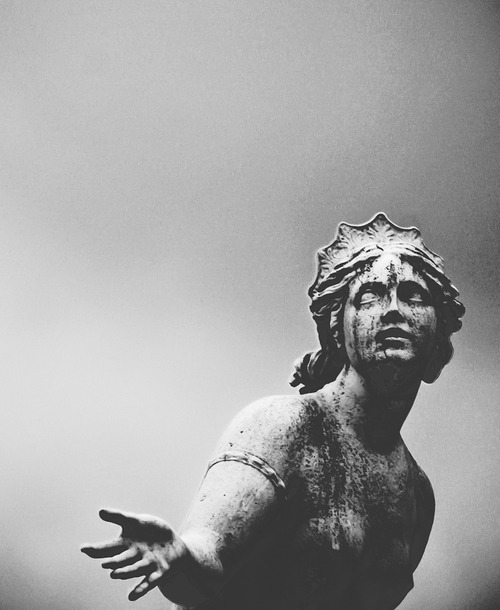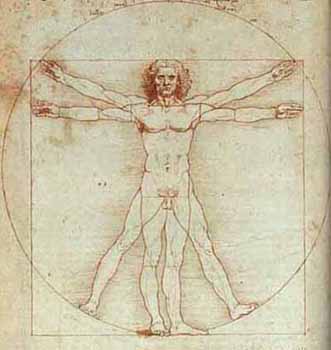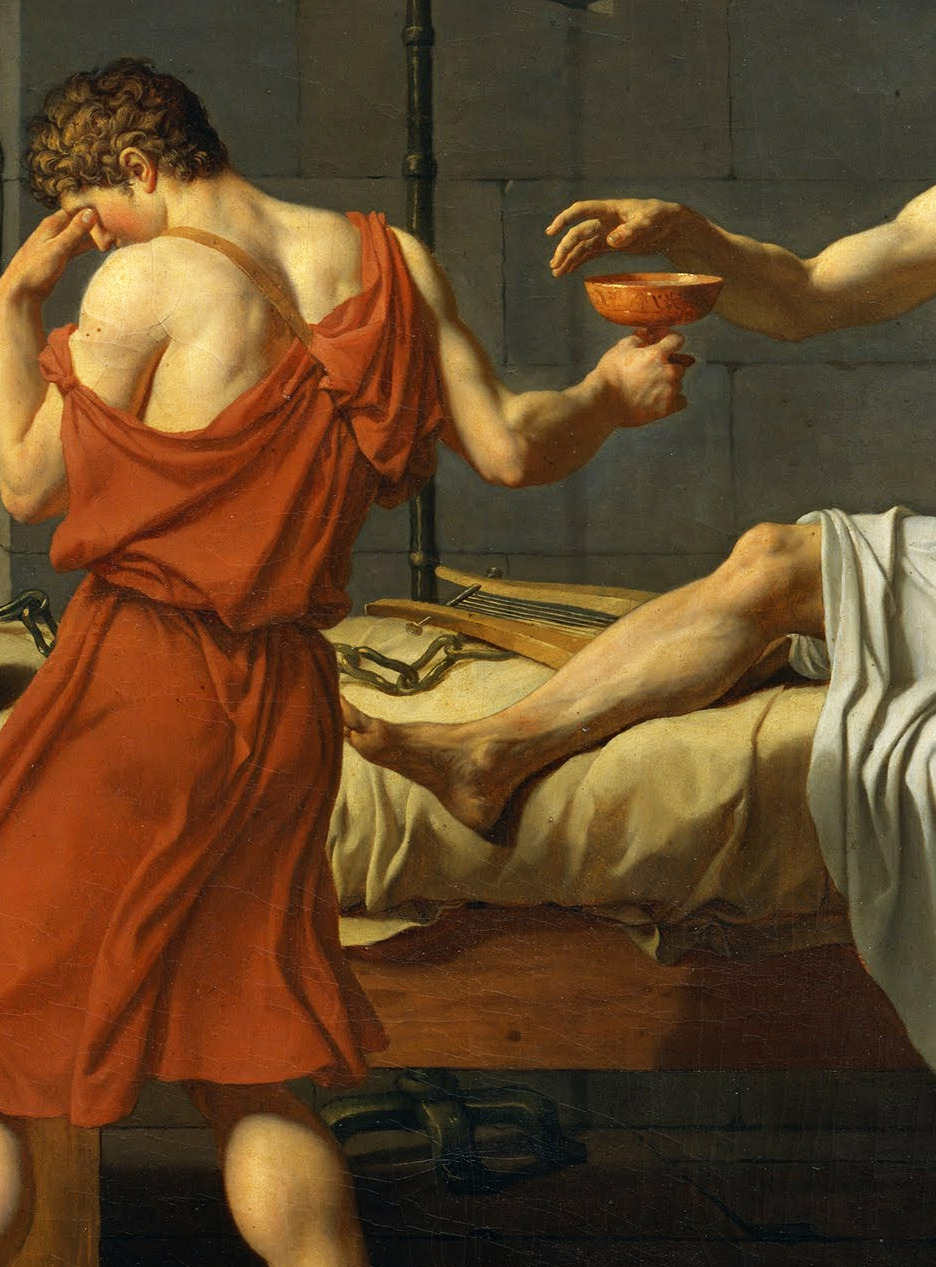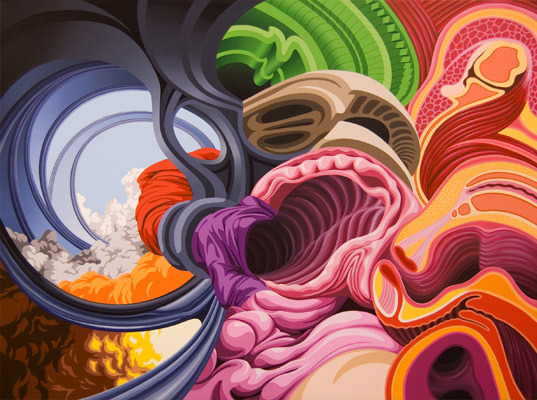
I. Deflection and Inscription
As stated in previous posts, the transcendence of God is a result of the impossibility to name, conceptualize, or reduce God. As the philosopher Lacan stated, we are dropped into an ocean of language and kept in its prison-house. Our language results from our historicity and cultural locality, born of interpretation, and we cannot think or interpret the world without it. We are forced to interpret the world in a particular context. Hence, there is nothing outside the text -- nothing outside of our interpretive experiences and historical moments. So when we speak of God, we ultimately speak of something we know not what. No man or woman has ever seen God.
God is the name we give to that thing which is always beyond the greatest thing we can conceive. God is the name of what we desire, why we desire, how we desire, and even of desire itself. Some say "God," others say Being or Tao or Spirit. Whatever the case may be, these words all point in the same direction, which is beyond all we see and toward something outside all locality and being, and beyond our origin itself.
For the philosopher Levinas, this meant that every attempt to name God was somewhat futile. Levinas was familiar with the Jewish tradition along with its ban on idols and indecipherable signifier for God, "YHWH." The Jewish forbiddance of idols had nothing to do with the noumenon, or the object-in-itself, and everything to do with the phenomenon, or the object-of-conciousness, the rendering of the noumenon via the interpretive Gaze. Hence, when any object is seen as an accurate representation or image of God, it becomes an idol - a reductive element. What this meant for Levinas is that any attempt to name God, describe God, etc., if it is to avoid the sin of idolatry, will result in
deflection.
Deflection means that the images, words, concepts, etc. will inevitably bounce back at the subject, exposing the fact that they were projected from the subject herself out of the materials of her mind. Levinas claims that deflection will result in "neighbor love." This means that when our Gaze is drawn away from dead materials we mistake for God, it is refocused on something that we know to be alive and conscious and responsive and perceivable: the human being.
In Genesis, the Divine grants human beings the "image of God," or the name of God. The only thing in experience that we are permitted to give the name of God to is the human being. This does not mean that the human being is equal to God, which would result in reductive idolatry and contradict the Judeo-Christian tradition's other teaching that humans are not equal to God. However, it does mean that God has chosen the human being to be the primary site of mediation, at least in the New Testament. The act of recognizing the human being as being that primary/primitive site of mediation is an act of
inscription. We are inscribing the name of God into the Other, identifying God within that particular site. We are not committing idolatry, but turning our Gaze toward creation's most privileged subject and finding an experience of God there rather than in wood, stone, words, or ideas.
II. Narrativity and Two Kenotic Events
Kenosis is a Greek word signifying the process of self-emptying. Divine kenosis is the self-emptying of God. Christianity contains two major kenotic events: genesis and re-genesis, or creation and new creation. But first a word on Christian narrativity.
Christianity can be understood as a type of metanarrative, but not according to the modern definition. As a narrative is does not posit a totalizing explanation of reality or function as a divine fiat making grand metaphysical claims such as so many dubious "truth-claims" in the Bible that have now been dismantled. Examples: the earth is flat, the earth is 6000 years old, the sun revolves around the earth, and a geocentric model and/or a three tiered world constitutes the universe we inhabit. Instead, the Christian narrative is a transhistorical collection of paradigmatic events and testaments that aid humanity by shedding light on our past and helping us think about the future. Christians ought to hold it as authoritative but not totalizing or inerrant. It helps them embrace mystery and suffering without resorting to nihilistic abandonment or mere naturalism, which encourage the embrace of animal instinct, focus on perpetuation of the species, and deter moral transcendence/responsibility. Christian religion, on the other hand, encourages ethical responsibility, transcendence of base instincts, agape, and self-sacrifice over against self-perpetuation.
In this vein, the two major kenotic events of the Christian narrative become very important. Here they are described in detail below.
1. Genesis
In the beginning, the wisdom of God ordered this vast cosmos into this intricate web of life. God, as the culmination of infinity and the Ground of all Being, enacted kenosis. God limited God's self by bracketing out infinity to create a space for finite creatures with self-determinative wills. This required limitations to be placed on God's infinite power. God did this because God is love, and God wanted to share this love with a finite creature that could respond in its own finitude to an infinite love. This was an act of self-sacrifice and self-limitation. It was a work of love. And God ultimately redirected our Gaze away from the infinite and toward the finite Other, whose own eyes speak of infinity.
2. Re-genesis
In the second beginning, the wisdom of God became flesh. Jesus was seen and heard as the Divine in flesh and blood. The Apostle Paul refers to this as Kenosis because Jesus was God emptying himself by becoming a finite vessel and ultimately, to become love and to become weakness. God revealed God's self in the finite and called it "Emmanuel," or God-with-us. God brought "new life" into a humanity of death.
The kenosis of Christ is a change in the structure of the Divine in the earthly domain. God is no longer located in temples or clouds or above mountains, but within the body of humanity itself, or as Paul says, "the body of Christ." In the crucifixion, the Divine takes on full solidarity with humanity, even experiencing existential atheism in the cry "My God, my God, why have you forsaken me?" The God of power, intervention, sovereignty, and magic "dies" in the existential realm. The Resurrection does not lead to God overpowering the world and its determinative wills, even as Jesus "ascends to the right hand of God" to become King, but rather it leads to a new creation. Pentecost, a dramatic reorientation of God's interaction with the world, culminates in a more humanistic form of religion. God descends upon the body of humanity in the form of the "Holy Spirit," thus raising up (read: resurrecting) a new humanity, a new body, the "body of Christ" or the earthly body of God.
The implications of this event are endless and astounding. Understanding them better could do so much for dealing with the problem of flimsy theodicies, our lack of magic and miracles in a scientific age, and the growing sense of human responsibility toward "the other" in our world today. When the Divine is encountered at the site of the Other, the call to justice emanates outward and demands our response. And when we respond, we fully identify with Christ, thus becoming
truly Christian.
III. "The House is God": Mark Z. Danielewski's Staircase, or a Literary/Aesthetic Perspective
In his postmodern novel of multilayered polyphonic narratives,
House of Leaves, Mark Z. Danielewski creates a grand sense of mystery within an infinite space spiralling down a staircase below a mere house. The House is a House of Mystery, a House of "Leaves," which not only brings to mind autumnal tranformations and elemental patterns of death and rebirth, but trails, paths, and especially counterpaths, or navigations away from the beaten path. The protagonist, Navy (read: Navi/gator), travels these "leaves" or counterpaths below/within the House, and he at one point claims that "the House is God." Which leads me to my point.
Invoking the subtitle of this blog, we (postmodern Christians) are following "counterpaths in the aftermath of God." We are leaving the beaten trail after having some mystical or luminous experience of the Divine, however deconstructive it may have been, and we are finding our footing on new territory, that territory mostly being here. Right here on planet earth.
So God is like Danielewski's spiral staircase. When Navy descended down this staircase, he became lost in a labyrinth of mystery. When the mystery ascended the staircase and entered the rest of the house, it resulted in violent disruptions. This is a bit of an inversion of traditional theistic understandings: we think of man as attempting to "ascend" to God to make contact (think: Babel), and we think of God's "descent" to man to identify more immanently. So Danielewski's inversion of ascent and descent relativizes the whole thing, especially with the notion that the whole thing
is God.
And speaking of Babel, the writer Jorge Borges speaks of the universe as an infinite spiral or library in "The Library of Babel." This infinite library contains endless books from ancient to modern, all the way from contemporary and simple to old, mysterious, and incomprehensible. Men get lost in this library searching for God. On top of that, because it is infinite, any given place at any time is the center, or else there is no center. It reminds me of Gianni Vattimo's definition of nihilism (in the words of John Caputo): the emptying of Being into interpretive structure. So what if God displayed God's infinity in the structure of human language and thus endless interpretation? There would be no beginning or end, no center, or else everywhere is a center. Borges also briefly compares this library to a pyramid. Imagine that the pyramid begins at the pointed tip in the heaven and then widens in its descent. Now imagine God descending or "emptying" from the heavens and widening out into the endless interpretive structures of human language. Imagine how travelling the presence of God could be like travelling an infinite spiral staircase in an infinite library.
And so God is like this spiral staircase mentioned by Borges and Danielewski, and Danielewski's staircase changes shape and form infinitely.
First, a note on the descension into mystery. When Navy descends the spiral staircase, he becomes totally lost, until all forms disappear, including the staircase. What happens is he is forced to turn inward, to look into himself at his own psyche, illusions, problems, etc. This gives him more integrity. In his return to the natural world, his Gaze turns outward toward the Other, and he learns to ground himself in the ordinary. This is parallel with the descending (immanent) God of the NT (Christ), which results in integrity and neighbor love.
Second, a note on the ascension of the mystery. The violent disruption of the mystery into the House results in death and destruction. It also causes the House to reinvent and reorganize itself. This is parallel with the ascending (transcendent) God of the OT, which results in violent intervention and reorganization.
What we have here is a two way kenosis: God empyting God's self into the creation, and humans emptying themselves into the mystery/God. Kenosis here is dialectical -- the mystery empties itself out into the human realm or body of humanity, and humanity empties itself out into this divine body that it identifies with, thus sacrificing autonomy. The dialectical kenosis here is another meaning for "union with God."
IV. The Impossible Future
In an upcoming post, I will deal a little more with the issue of eschatology. But for how, here are a few notes on the future. The future can be seen under the following three qualifiers: the absolute future, the unforeseeable future, and the impossible future.
First, the absolute future. What I mean by the absolute future is the future that stands completely apart from all conceivable futures, from all desired futures, and from all planned futures. It stands outside of the horizon of our predictions. Whatever the future is, it has not yet been written because it has not yet happened. And many of the factors which shall determine it are out of our hands. This makes the future impossible because it stands partly outside of the realm of our own possibility and potentiality. And this makes it absolute because nothing we can do now will completely determine it.
Second, the unforeseeable future. The future is unforeseeable simply because it is not yet written and because it is absolute and uncertain. We are forced to thrust ourselves into the unforeseeable future and into impossibility.
Third, the impossible future. The future is impossible precisely because what is now possible has only partly to do with what is yet to be possible.
God is like these three qualifiers. God is absolute, unforeseeable, and impossible. God is absolute because God cannot be completely determined, and is only partly determined because of kenosis. God is unforeseeable because God is unpredictable. God is impossible because God transcends the realm of our possibilities. This has important implications for how we view the future of God.
Some thinkers look at our history up until this point and claim that because God has taken the direction of continual kenosis, there will be no overpowering final judgment and no reversal in this Divine self-emptying. But we cannot know for sure. The extent to which God became kenotic in Christ could never have been predicted by the OT prophecies or even by God's kenosis at the creation of the universe. How are we to know what the future holds exactly? God lies in the absolute, unforeseeable, impossible future, beyond our grasp. But what we do know up until this point is that the Divine autobiography in time has taken a strongly kenotic direction.





















